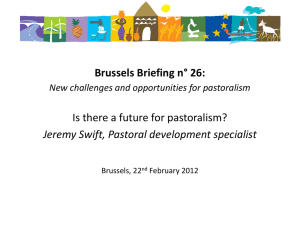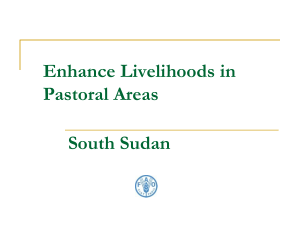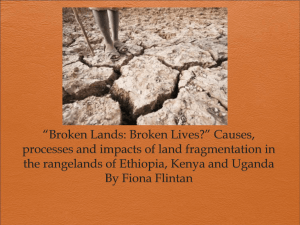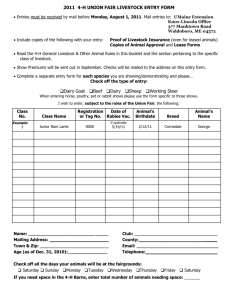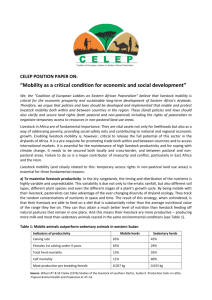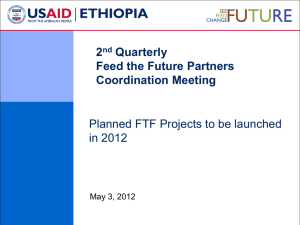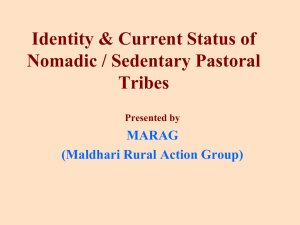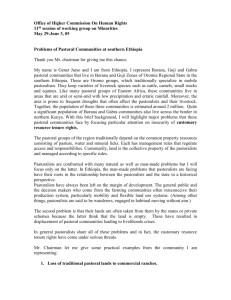Development planners should work to
advertisement
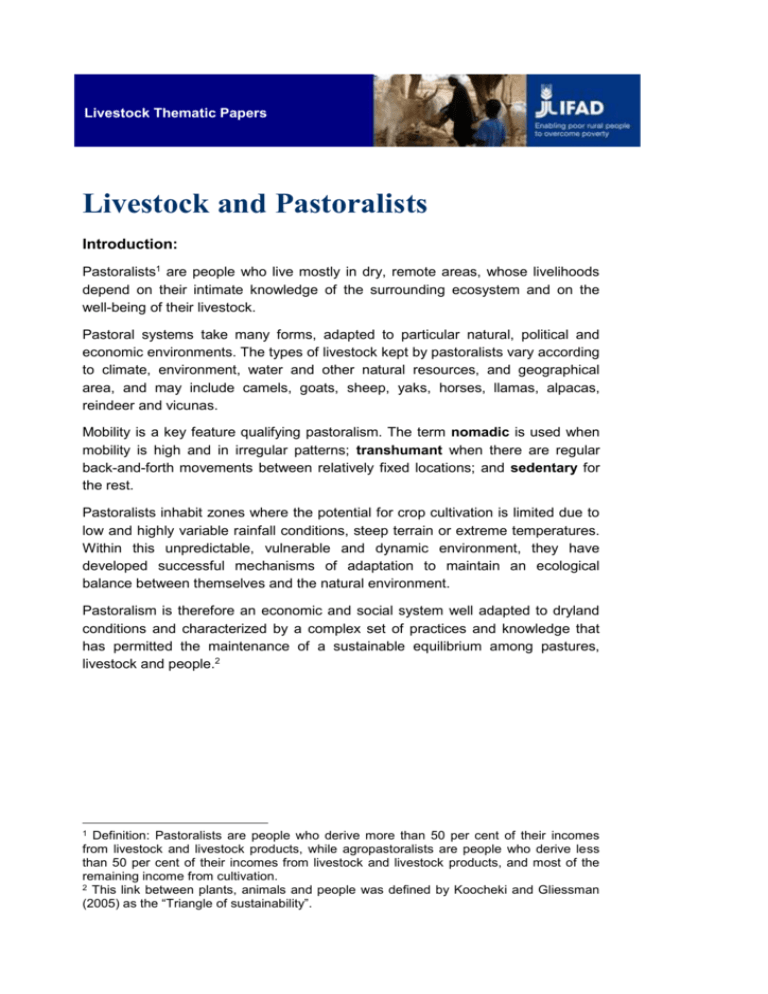
Livestock Thematic Papers Livestock and Pastoralists Introduction: Pastoralists1 are people who live mostly in dry, remote areas, whose livelihoods depend on their intimate knowledge of the surrounding ecosystem and on the well-being of their livestock. Pastoral systems take many forms, adapted to particular natural, political and economic environments. The types of livestock kept by pastoralists vary according to climate, environment, water and other natural resources, and geographical area, and may include camels, goats, sheep, yaks, horses, llamas, alpacas, reindeer and vicunas. Mobility is a key feature qualifying pastoralism. The term nomadic is used when mobility is high and in irregular patterns; transhumant when there are regular back-and-forth movements between relatively fixed locations; and sedentary for the rest. Pastoralists inhabit zones where the potential for crop cultivation is limited due to low and highly variable rainfall conditions, steep terrain or extreme temperatures. Within this unpredictable, vulnerable and dynamic environment, they have developed successful mechanisms of adaptation to maintain an ecological balance between themselves and the natural environment. Pastoralism is therefore an economic and social system well adapted to dryland conditions and characterized by a complex set of practices and knowledge that has permitted the maintenance of a sustainable equilibrium among pastures, livestock and people.2 1 Definition: Pastoralists are people who derive more than 50 per cent of their incomes from livestock and livestock products, while agropastoralists are people who derive less than 50 per cent of their incomes from livestock and livestock products, and most of the remaining income from cultivation. 2 This link between plants, animals and people was defined by Koocheki and Gliessman (2005) as the “Triangle of sustainability”. Pastoralism: A Sustainable Natural Resource Management System Adaptation Mobility Livestock Mutual Support Traditional Knowledge Pastures People Diversification Flexibility Conservation Today there are nearly 200 million pastoralists in the world generating income where conventional farming is limited or not possible. However, pastoral communities are marginalized and generally not given due consideration in wider socio-political analysis. Although the livelihoods of these communities are vulnerable to climate change, shifting global markets, population growth and increased competition for land and other natural resources, pastoralism remains a viable natural resource management system, and understating its rationale, importance and dynamics is a key element in efforts to reduce poverty. Pastoralism in Brief Main Characteristics Mobility, livestock adaptation and diversification, mutual support, biodiversity conservation. But also limited access to natural resources, knowledge and markets; nonviable herd sizes, suboptimal age/sex ratio of the herd or flock. Livestock Species Camels, goats, sheep, yaks, horses, llamas, alpacas, reindeer and vicunas. Main Production Services Vulnerabilities Concerns Milk, fibre, meat Droughts, floods, terms of trade, political instability, poor access to services (veterinary services, credit, markets, training and inputs), technologies and innovations. Animal theft. Growing population pressure. Development of risk management, community organizations, appropriate land rights, integration of pastoral systems and natural resource management. Sedentarization, environmental management, development of integrated crop-livestock farming systems, market development, strengthening of producer organizations. Source: Adapted from table 1.2, Typology of poor livestock keepers, in IFAD,.Livestock Services and the Poor, 2004. Key principles: Sustainability. Adaptation to a stressful environment, conservation of ecosystem diversity and mobility are the win-win components that make pastoralism sustainable. Empowerment. Pastoralists need to be empowered to engage in decision- and policy-making processes, and to tackle marginalization, which is a root cause of pastoral poverty. Flexibility. Enhancing the economic and environmental sustainability of drylands cannot be achieved by substituting pastoralism with other, less flexible systems. Strategies: The following strategies are used by pastoralists to manage the environment in a sustainable way while also (a) assuring a continuous food supply, (b) minimizing risks to people and livestock, (c) avoiding disease outbreaks and (d) containing social and political instability: Livestock adaptation. Pastoralists own any of a wide range of indigenous livestock selected on the basis of survival and productivity, and well adapted to the prevailing climatic conditions. Their rangelands are also characterized by species diversity to optimize different range resources and conserve the ecosystem. Mobility. Economically logical and environmentally essential, mobility is, in fact, the only way to make sustainable use of rangelands. The pastoral system is moved to fit the environment in order to make the best use of the available resources. Mobility enables pastoralists to take advantage of pasture resources that are only seasonally accessible, and allows access to salt patches (critical for animal health) and other resources and services. Moreover, thanks to mobility, pastoralists can obtain sufficient supplies of food, forage and water, or avoid disease outbreaks. Diversification of livestock species and breeds. By keeping more than one species of livestock, pastoralists can generate a wider variety of livestock products and make better use of the available forage in different seasons, even in times of crisis. Reserve of rich-patch vegetation areas. Pastoralists set aside grazing areas to use as a bank during the dry season or drought times. Maximization of stock numbers. Such accumulation helps ensure survival of herds despite losses incurred during droughts or disease outbreaks. It also represents a method to accumulate food stock and marketable assets – at the risk minimization stage – that they can eventually sell at the risk absorption stage, when all efforts are directed to sustaining the most valuable animals while the less valuable are used to buy food. 3 Splitting of herds. Generally, this is a coping strategy aiming at reducing competition among herds for forage and water resources and optimizing pasture use. In times of crisis, it is mainly a principle of mutual assistance whereby pastoralists ensure optimal conditions and habits for the animals through reciprocal exchanges and support. Redistribution of assets. Mutually supportive relationships among pastoral communities assure that, in times of need, food, cash and labour are redistributed on a reciprocal basis. It is important to note that pastoralists have strong traditional institutions that play a significant role in periods of stress. Specifically, they regulate natural resource use and conservation, manage risks, protect resources and promote collective actions for mutual safety. Constraints: Sedenterization policies. Many pastoralists have become increasingly sedentary as a result of explicit government policies or to take advantage of infrastructure and social services. Water development. Water points are often established without taking into consideration traditional migration routes. Moreover, they can sometimes be the cause of land degradation in the surrounding lands. Market constraints. These include high transaction costs, low competition in the supply of goods and services, high standards, etc., making it difficult for pastoralists to convert livestock in times of stress. (Moreover, pastoralists are often price takers rather than price makers). Access to high-value export markets remains elusive to pastoralists. Growing population pressure. One of the consequences of population growth is to make pastoral economies less self-sufficient. Other constraints. These include limited access to financial services, poor delivery of social services, low literacy levels, insecure land tenure and absence of basic infrastructure. New challenges and opportunities for pastoralism: Equitable access to land, water resources and secure land-use systems, including protection of pastures from encroachment and strengthening of local and/or customary systems so that they are better able to negotiate dry-season access to key resources for pastoralists; Expansion of trade, integration of markets and increasing regional interconnectivity, together with high and growing demand for animal proteins all over the world; Conflict avoidance. Pastoralists’ reliance on mobility makes them particularly vulnerable to conflict and fear of conflict, which can cut off their access to key resources and block them from important markets. This is peculiar to certain countries (e.g. in East Africa) where rule of law is weak. Technological developments enhancing mobility and telecommunications (e.g. geographic information systems to map the state of rangeland resources); Control of transboundary animal diseases (e.g. foot-and-mouth disease, rift valley fever, peste des petits ruminants, etc.) as a prerequisite for tapping into global markets. For instance, stringent sanitary standards for international trade in animals and animal products have limited the export of livestock products to profitable international markets (e.g. from countries of the Horn of Africa to Saudi Arabia); Enhancement of interlinkages among livestock producers, including pastoralists, as part of the development of domestic markets in developing countries to cope with increased demand for meat and milk. Key issues/questions in project design: Development planners should work to: Develop incentives to promote the social and economic security of pastoral communities, while respecting their knowledge systems and collaborating with customary pastoral institutions; Foster market integration and boost the subsistence economy of pastoralists through mechanisms that encourage their traditional, sustainable use of natural resources; and Provide appropriate services, i.e. services that are efficient, culturally sensitive and sometimes mobile. Within this framework, key questions to be asked when designing projects are: Is the project taking the specific needs of pastoral systems into consideration? Have different socio-economic subgroups been identified and targeted within the wider group of pastoral people? Does the project support alternative dryland livelihoods that inappropriately divert labour and other resources from the pastoral system? Does the project influence power relations among pastoralists, local institutions and the state? Does the project promote policy dialogue between pastoralists and local institutions? Do project activities impact on pastoral land use systems or influence pastoral mobility? Are incentives created for diverting natural resources into other forms of production and does this impact on pastoralism? 5 Are financial services accessible to pastoralists and adapted to the realities of the pastoral system? Does the project enable pastoralists to access markets and respond to the demand for pastoral livestock products? Does the project take into account the gender-related division of labour and boost the capacity of pastoralist women? Do social services and infrastructure accommodate the needs of pastoralists? Recommendations and Lessons Learned: Greater efforts are required to ensure the participation of pastoral people in all stages of project development; More attention needs to be paid to collecting and analysing context-specific data in order to gain a better understanding of the socio-economic value of pastoralism; Policymakers need to create an enabling institutional environment at state and local government levels that is sensitive to the specific needs and constraints of pastoralists and also provides them with space and authority for decisionmaking. To reverse rangeland degradation, customary and local institutions need to be strengthened so that they can make better use of traditional knowledge and ensure that pastoralism continues to be practised and managed effectively and autonomously, without external pressures. Development planners should have a clear understanding of the national policy context, of supportive and unsupportive policies, and of the general attitude of government towards pastoralism. A special focus on pastoralist-related issues and constraints is also required in poverty reduction strategy papers. More attention should be devoted to indigenous environmental knowledge, which emphasizes the preservation of species and habitats, thus contributing to biodiversity and making pastoralism essential for the ecosystem health of dryland environments. Risks are an unavoidable part of pastoral life. The attitudes of pastoralists towards risk and their adaptation to it show that ways exist to cohabit with it. On the other hand, development planners and policymakers tend to put mechanisms in place to minimize or avoid risk, creating dangerous external pressures that distort pastoralist dynamics. PASTORALIST WOMEN The challenge of poverty reduction in pastoralist areas is compounded by the complex relationships between pastoralist women and men – their roles, rights and responsibilities – and between them and the natural resource base on which they depend. Women play a significant role in pastoral communities and are key agents in livelihood development. Within pastoralist societies, the use of labour is highly gender-specific, and women traditionally play important roles. They are engaged in socio-economic and cultural activities, and also in the conservation and management of natural resources. However, the great majority of pastoral societies continue to be dominated by men, and women’s participation in decisionmaking processes is limited or totally absent. Decisions regarding herd mobility, planning, conflict resolution, and relations with neighbouring groups are usually made by older men. With some exceptions, men own the animals and have sole rights to dispose of them through sale and slaughter. In many rural societies, women are customarily responsible for milking, and the processing and marketing of milk and dairy products (although, in some societies, milking is not done by women at all or they are allowed to milk only certain kinds of stock). In addition, women generally have mothering and domestic responsibilities; care for animals kept near the homestead and for young and sick livestock, and, when moving to new pastures, may also be involved in dismantling and rebuilding their houses. Within this context, recommendations for project design include an emphasis on: Understanding the basic needs of pastoral women, the threats they face, their roles in pastoral societies and how these roles are changing; Supporting women’s empowerment, looking not only at how to enable pastoralists to become more market-oriented, but in particular at how to ensure that women capture the benefits of economic empowerment; Supporting women’s access to productive resources and main assets (water, land, fuelwood, markets, knowledge), promoting their participation in smallscale dairying and strengthening their role in decision-making processes; Understanding how women influence decisions and what resources they have greater control over; Incorporating the concerns of pastoralist women in project design and ensuring women's active participation and involvement in the different project phases and activities; and Supporting income-generating activities (for instance, processing and selling of livestock, forage, aromatic/medicinal plants and wildlife products) as a way to enhance pastoralist women’s socio-economic position in the household and empower them to take a greater role in the community. At the same time, it is important to recognize that, because of their extremely heavy workloads, women have fewer opportunities to diversify or maximize their livelihoods. Time-saving opportunities, therefore, merit special attention. 7 Potentialities of Camel Milk: The Experience of Tiviski dairy Tiviski is the first dairy in Africa and the second in the world to pasteurize camel milk. It is based in Mauritania, and processes camel milk into modern, high-quality market products (including cream, yoghurt and cottage cheese). Although it is generally true that more needs to be done to improve methods for preserving raw camel milk, this small dairy is a positive example of how to (a) use appropriate technologies to develop "good" camel milk production, (b) apply appropriate collecting and processing practices to ensure the safety and quality of camel milk and dairy products; and (c) develop camel milk and dairy product standards to facilitate trade and export to the rest of the world. The mini dairy started up in 1989, when camels were used almost exclusively as a means of transport. Despite some initial constraints (such as the traditional prejudice against selling milk and a consumer preference for imported goods), high-quality fresh dairy products eventually won over imported sterilized milk, and sales gradually increased. In 2002, milk deliveries reached 20,000 litres a day, but a drought dealt a severe blow to the sector. Over the years, herders have found that the regular income from milk sales has improved their living standards and enabled them to feed their livestock in dry periods. Today, thousands of camels, cows and goats are milked by hand, wherever they happen to be, and a network of pick-up vehicles carry the milk churns twice a day, over distances of up to 90 km, to three collecting centres located in towns along the Senegal River. Herds continue to move around, their owners still live in tents or huts in the traditional way, but 1,000 households receive a regular income from their milk. The dairy also provides veterinary care, vaccination and feed, on credit, as well as instruction in hygiene. With the help of the Food and Agriculture Organization of the United Nations, the dairy also discovered how to curdle camel milk (which does not curdle naturally), and two types of cheese were made and “designed” for the European market, cheese not being a tradition in Mauritania. Unfortunately, European regulations do not include camel milk: new regulations must therefore be specially drafted. It is hoped that camel cheese will be exportable soon. Advantages and Lessons Learned: A camel’s lactating period is longer than a cow’s. Moreover, camel milk is produced even under dry conditions, and to some extent it preserves its qualities under harsh climatic extremes, thus providing options for transport and processing in dryland environments. Camel milk is slightly saltier than cow’s milk and it is richer in iron, minerals, vitamins (three times as rich in vitamin C) and unsaturated fatty acids, while its fat content is low. It is a natural and essential food item in areas where water and forage are scarce. Milk is from two to three times more valuable than meat in the pastoral economy, yet government, donor and NGO investments all focus on marketing of meat and livestock. The promotion/marketing of camel milk and dairy products is an efficient way to link producer groups to processors and consumers. Camel dairy products could provide nomadic communities not only more food but also an important source of income. The Future of Pastoralism in Ethiopia3 Ethiopia has Africa’s largest livestock population. Over 60 per cent of its land area is semi-arid lowland, dominated by a livestock economy. To gain a fuller understanding of pastoralist regions, the Pastoralist Communication Initiative of the United Nations Office for the Coordination of Humanitarian Affairs, together with Ethiopian officials and pastoralist leaders, considered some of the choices pastoralists may make over the next 20 years in order to adapt to changing circumstances. Four possible scenarios were envisaged. The analysis took into account the special nature of the lowlands, their natural resources, and the influences of climate, international markets, economy and governance. Below are excerpts from the publication and its summary: Scenario 1- Expanding export trade: With local land use management allowing sufficient resources for sustaining livestock production and a further opening of foreign markets,, pastoralists export increasing quantities of animals and animal products. Pastoralists and traders enjoy immediate benefits from the rising price of livestock, while increased foreign exchange inflow boosts the value of the Birr. The livestock sector in non-OECD countries is growing at a rate of up to 7 per cent per year and is expected to by the most important sub-sector in terms of added value by 2020. In this context, a possible scenario is that pastoralists have better access to markets and better technology. This should result in a better capacity to produce and deliver products of higher quality and value. Pastoralists and traders would benefit from the rising price of livestock, while increased foreign exchange would increase government revenues. Lowland traders today complain that the cost and inefficiencies of current taxation and licensing systems drive them to the illegal trade. “Thus their commodities and trucks are at risk from confiscation, government loses potential revenue and unrestrained animal movement promotes the spread of trans-boundary diseases. In a future where these problems have been overcome, government and traders will have arrived at new ways of regulating and promoting cross-border and export trade. There will be agreements on regional integration and free movement of stock and measures to allow for the taxation and certification of livestock herded or transported to markets across borders. In this future, suppliers will be using market and technical information to respond to price incentives, quickly increasing production and delivery and improving the quality of their products. They will be enjoying legal rights of access to land and other productive resources administered by institutions that include both traditional and state representation. Reliance on foreign markets will mean new risks. Elites may accumulate excessive profits leaving the poorer members of society dependent upon them for employment. Livelihoods can quickly become contingent on tariffs, quality and health requirements and other barriers to trade. Subsidies in other countries could threaten to erode the competitiveness of Ethiopian pastoralists, and with Ethiopia dependent on access to international ports through neighbouring countries, regional conflicts could disrupt trade. Making this scenario work well requires good governance and a fair society. 3Excerpts from United Nations Office for the Coordination of Humanitarian Affairs 2007A and b. 9 Scenario 2 - Added Value: Despite efforts to protect pasture from encroachment and to enable local and customary systems to negotiate dry season access to key resources for pastoralists, global climate change leads to increasingly unreliable rainfall by 2025. Livestock production and farming fail to keep pace with population growth and some pastoralists … have begun to find other ways to make a living. Highprice foreign markets become more accessible to Ethiopian products and expastoralists begin to develop new livestock-based products for sale at home and abroad. If the climate is less generous, but high-price foreign markets are still accessible, then lowlanders will add value to livestock production, rather than being able to increase the quantity of animals produced and sold. Successful pastoralists will need high levels of mobility in order to produce quality animals in a harsh climatic regime. There will be fewer pastoralists, and people will diversify into a range of business activities such as forage supply, fattening, food processing and high quality manufacturing from skins and hides. Local authorities will administer the collection of value added taxes which will be reinvested in supporting the local economy and social welfare. New roads and communication systems will help to get products to market intact and on time. Too much reliance on rain-dependent products will add an element of risk to this scenario. High levels of conflict would also endanger success by interrupting pastoralist mobility, discouraging investment into value added industries and hampering access to markets. The success of this scenario is based on freeing up lowland capabilities to invest in new small industries and to access export markets. It also relies on securing pastoralist abilities to be mobile and deliver animal products to the market despite the difficulties of a poor climate. Scenario 3 - Sustained Pastoral Livelihoods With mechanisms in place to guarantee pastoralists access to key natural resources, 20 years from now a vibrant pastoral production system continues. Access to high-value export markets, however, remains elusive to pastoralists. Pastoralists are experts at maximizing the use of rangelands and, moving between seasonal grazing areas, they will achieve high levels of productivity taking strategic advantage of different forage and water sources as they become available. Social services such as education and health will be tailored to mobile lifestyles in pastoral areas and support the growth of the rural economy. Pastoralists, in cooperation with farmers, will work with government on the control of bush encroachment to conserve grazing pasture. “Decentralized land-use institutions will have to guarantee access to key resource areas, even during the dry season, while legal instruments will provide clarity as to rights of land use. Traditional and modern knowledge will be combined in guiding range management decisions.” International markets may remain hard to access (due to quality standards and other barriers), while regional integration and free movement of stock will increase cross-border trade with neighbouring countries as a instrument for hedging e the risk of any fall in national demand. Moreover, investments in infrastructure (i.e. roads and communications) will help provide market information and reduce transport costs by connecting pastoral areas to small production centres. Such measures maximize prices for the producer. “What makes this scenario successful is that policy-makers come to recognize that the pastoral production system is a source of strength supporting market development, primary veterinary service and effective resource management/land administration. These aspects will benefit livestock production, while links to local and regional markets help to secure livelihoods across the lowland population.” Scenario 4 - Alternative Livelihoods Both markets and production are poor, and people seek alternative livelihoods. Reduced access to good grazing and lack of market access will prompt many pastoralists to look for better opportunities in rural towns and urban centres. The pastoralists who continue to herd animals will eventually gain from the increase in alternative businesses and services and continued demand for livestock products. People who move into alternative livelihoods will invest in the pastoralist system and may rejoin it at will. Government will offer tax incentives to encourage private investors to invest in pastoral areas, especially where investments diversify and strengthen pastoral production. Traditional and state administrations will work together to ensure that new economic activities are successfully integrated into society and are regulated effectively. This may be the most difficult scenario to make successful, with the highest requirement for social welfare and high collaboration between customary institutions and the state. Livelihoods will become more diverse and secure and the range of resources available in pastoral areas better utilized. Success will rely on securing good citizen-state relations in management of scarce resources, as much as on investing in education and reducing barriers to innovation. For a positive future under difficult conditions, customary institutions will need to continue to play a central role in welfare, inter-community negotiations and management of communal access to key resource areas. 11 Sources of Information and Examples of Best Practice Outside of IFAD Blench, R. 2001. You can’t go home again: Pastoralism in the New Millennium. Overseas Development Institute report for the Food and Agriculture Organization of the United Nations. London: ODI. Available online at http://www.odi.org.uk/pdn/eps.pdf Food and Agriculture Organization of the United Nations (FAO). AGA News. “Milking the camel”. Animal Production and Health Division, Agriculture Department. Rome: FAO. Available online at http://www.fao.org/AG/againfo/home/en/camel.html Food and Agriculture Organization of the United Nations (FAO) 1997. Literature Review on Nomadic Women and the Use of Rangelands”. Rome: FAO. Koocheki, A. and R. Gliessman. 2005. “Pastoral Nomadism: A Sustainable System for Grazing Land Management in Arid Areas”, in Journal of Development Agriculture, Vol. 25, Issue 4. Musimba, N.K. 1997. “Pastoral and Agro-pastoral Extension Services: How They Differ from Conventional Livestock Development Extension Services”, in Dryland Husbandry in Kenya. Dryland Husbandary Project (DHP) Publications Series, no 2. Addis Ababa: Organization for Social Science Research in Eastern and Southern Africa. Royal Tropical Institute and International Institute of Rural Reconstruction. 2006. Chain Empowerment: Supporting African Farmers to Develop Markets. Amsterdam: Royal Tropical Institute. United Nations Development Programme. 2003. The Global Drylands Imperative: Pastoralism and Mobility in the Drylands. Nairobi: United Nations Development Programme, Drylands Development Centre. Available online at http://www.undp.org/drylands/docs/cpapers/PASTORALISM%20PAPER%20FINAL.doc . United Nations Office for the Coordination of Humanitarian Affairs. Pastoralist Communication Initiative. 2007a. The Future of Pastoralism in Ethiopia. Addis Ababa: UN OCHA-PCI. Available online at http://www.pastoralists.org/pastoralistpdf/The-future-of-pastoralism.pdf . ______ 2007b, “The Future of Pastoralism in Ethiopia: 4 Possible Scenarios”, Addis Ababa: UN OCHA-PCI. Available online at http://www.pastoralists.org/pastoralist-pdf/Future_Past_Summary.pdf . Contact: Mr. Antonio Rota Senior Technical Adviser on Livestock and Farming Systems Tel: +39065459 2680 a.rota@ifad.org Ms. Silvia Sperandini Consultant Tel: +39065459 2070 s.sperandini@ifad.org 13
